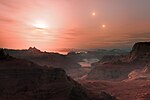| Observation data Epoch J2000 Equinox J2000 | |
|---|---|
| Constellation | Sagittiarus |
| Right ascension | 18 06 7.44 |
| Declination | −31° 24′ 16.12″ |
| Characteristics | |
| Evolutionary stage | white dwarf |
| Variable type | unknown |
| Astrometry | |
| Distance | 7500 ± 2000 ly (2300 ± 600 pc) |
| Details | |
| Mass | 0.53±0.11 M☉ |
| Other designations | |
| MOA 2010-BLG-477, MOA 2010-BLG-477L, MOA-2010-BLG-477 L | |
| Database references | |
| SIMBAD | The star |
| planet b | |
MOA-2010-BLG-477L is a star whose existence was detected when it caused a microlensing event in August, 2010. The microlensing event also revealed the existence of a planet orbiting the star. At first the star was thought to be about 0.67 times the mass of the Sun, in the main-sequence phase of its stellar evolution. But by the time the star should have been separated enough in the sky from the source star of the microlensing event it was not detected, implying that it is actually a dim white dwarf star.
Planetary system
| Companion (in order from star) |
Mass | Semimajor axis (AU) |
Orbital period (days) |
Eccentricity | Inclination | Radius |
|---|---|---|---|---|---|---|
| b | 1.5−0.3 MJ | 2−1 | — | — | — | — |
The history of the detection of the planet, MOA-2010-BLG-477 L b, dates back to the year 2010. In that year, a microlensing alert event occurred, before the planet was confirmed conclusively, and was detected independently by the MOA and OGLE collaborations. Following the original microlensing event, astronomers predicted another microlensing peak, which was observed by numerous groups using a wide array of telescopes. One of these telescopes was located in Antarctica, and made the first microlensing detections from that continent; however, the data collected there were too crude to be included in the analysis which eventually confirmed the planet.
The planet was detected by means of microlensing, where gravitational lensing as the planet and its host star pass in front of a background star causes a temporary flare in the amount of light observed, allowing the planet's existence to be known.
Observations from the Keck Observatory in Hawaii allowed a team from Australia and New Zealand to study the system in more detail. They determined that the star was a white dwarf, and that the planet was similar in mass to Jupiter. The gas giant planet was found to be about 2.8 AU, or about 260 million miles, away from the white dwarf star, which is about half the mass of the Sun. The discovery of MOA-2010-BLG-477 L b drew significant attention, as it shows a potential scenario for Jupiter's continued orbit around the Sun in the distant future, after the star's own evolution into a white dwarf.
MOA-2010-BLG-477 L b is the only planet which has been detected orbiting MOA-2010-BLG-477 L. Little is known about this planet, with the only characteristics known about this system are the mass of the planet and its projected separation from its host star.
See also
- List of exoplanets and planetary debris around white dwarfs
- List of exoplanets detected by microlensing
- KMT-2020-BLG-0414L
References
- ^ Bachelet, E.; Shin, I.-G.; Han, C.; Fouqué, P.; Gould, A.; Menzies, J. W.; Beaulieu, J.-P.; Bennett, D. P.; et al. (2012). "MOA-2010-BLG-477Lb: Constraining the mass of a microlensing planet from microlensing parallax, orbital motion and detection of blended light". The Astrophysical Journal. 754 (1): 73. arXiv:1205.6323. Bibcode:2012ApJ...754...73B. doi:10.1088/0004-637X/754/1/73. S2CID 119223374.
- ^ Blackman, J. W.; Beaulieu, J. P.; Bennett, D. P.; Danielski, C.; Alard, C.; Cole, A. A.; Vandorou, A.; Ranc, C.; Terry, S. K.; Bhattacharya, A.; Bond, I.; Bachelet, E.; Veras, D.; Koshimoto, N.; Batista, V.; Marquette, J. B. (2021), "A Jovian analogue orbiting a white dwarf star", Nature, 598 (7880): 272–275, arXiv:2110.07934, doi:10.1038/s41586-021-03869-6, PMID 34646001, S2CID 238860454
- ^ Schneider, Jean (14 October 2021). "Planet MOA-2010-BLG-477L b.". Extrasolar Planets Encyclopaedia.
- Blackman J. W. et al. A Jovian analogue orbiting a white dwarf star // Nature volume 598, pages 272–275, 13 October 2021
- Chen Ly (Oct 23, 2021). "Jupiter-like planet survived the death of its star without harm". New Scientist.
- Ferreira, Becky (2021-10-13). "Astronomers Found a Planet That Survived Its Star's Death". The New York Times. ISSN 0362-4331. Retrieved 2022-05-16.
| 2012 in space | ||
|---|---|---|
| Space probe launches |
|    |
| Impact events | ||
| Selected NEOs | ||
| Exoplanets |
| |
| Discoveries | ||
| Comets | ||
| Space exploration | ||